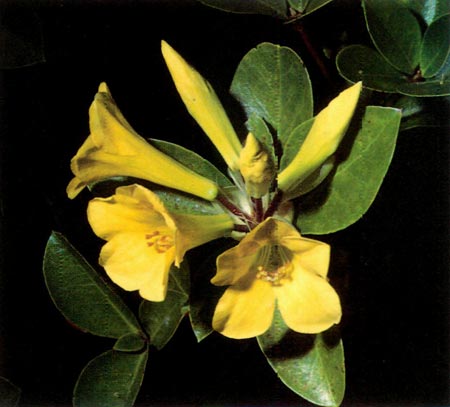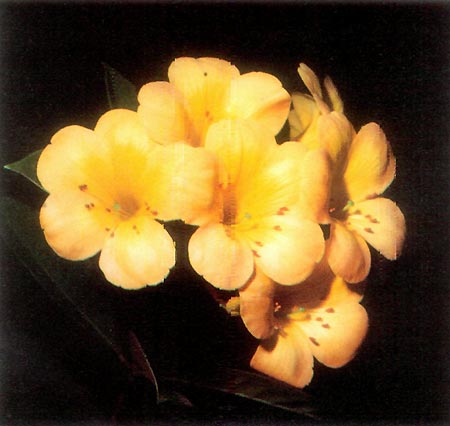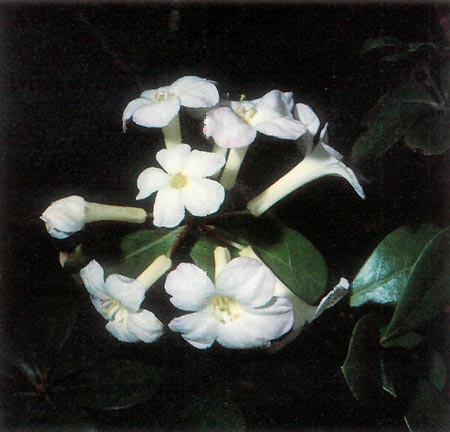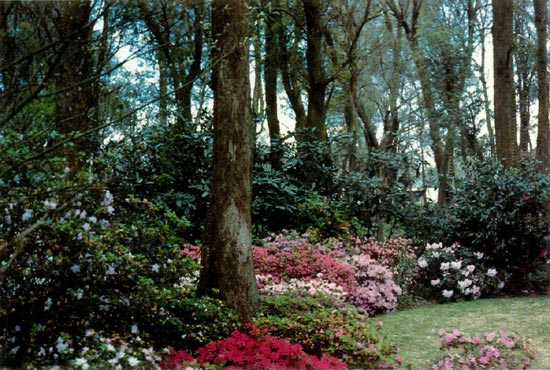JARS 43n1 - Rhododendrons Down-Under
Rhododendrons Down-Under
Herb and Betty Spady
Salem, Oregon
Recollections of the recent International Rhododendron Conference held in Wollongong, Australia, must be quite varied as the subjects considered were very wide ranging. To a casual reader of the program it appeared to be a conference devoted to Vireya rhododendrons. Although that section of the genus was discussed in some detail, there was much other information.
Interesting discussions regarding subsection Tsutsusi ranged from the possibility of someday developing yellow evergreen azaleas by genetic manipulations to the remarkable and unusual variations of the collection of Hideo Suzuki and discussions on new evergreen and deciduous azalea material appearing in the USA (Fred Galle). On the more scientific side a careful study by Yasuke Sakata using biochemical and morphological studies identified R. sataense as a natural hybrid of R. kaempferi and R. kiusianum .
Dr. David Chamberlain praised the study as just the type of work that is needed to define the relationships between species. He commented in his talk that 185 new species have been described from Chinese material since 1955 and that many of them may turn out to be hybrids when population studies of this type are performed. He identified R. agastum (possibly R. decorum x R. arboreum ), R. diphrocalyx (possibly R. habrotrichum x R. facetum ) and R. dimitrium (possibly R. neriiflorum x) as probable natural hybrids. A population and morphological study by Ming-Yuan Fang of subsection Irrorata identified five groups within the subsection on the basis of corolla shape and the presence or absence of glandular hairs on the ovaries or stamens. He described a new species R. guizhouense .
Because R. lochiae is a native of Australia and because several sites on the tours had Vireyas growing outdoors the emphasis on the subgenus seemed very appropriate. No speaker was better qualified to describe a long experience with these "tropical" members of the genus than Rev. Norman Cruttwell. He described his plant explorations in the region of Papua New Guinea extending back to 1946. His interest resulted in the introduction of several new species. He indicated the existence of many natural hybrids. He reported four methods of pollination related to the character of the flower.

|
|---|
Vireya - Illawarra Garden Photo by Herb Spady |
The ability to obtain hybrids under cultural conditions may be related to such natural methods of pollination. Dr. John Rouse presented a study that related the success in hybridization to compatible style lengths. The more disparate the style lengths the less likely the success of the effort. The more closely style lengths matched the more successful was pollenization. He stated that by using species with intermediate lengths bridging could be obtained. He described the production of seed from vireya x azalea complex, but with resulting sterile unthrifty plants. No seed was obtained by the opposite cross.
Graham Smith described Vireyas as warm temperate plants and not tropical plants. He discussed his observations in the wild of these plants growing in frost protected sites even in areas where frosts naturally occurred. He re-emphasized the need for excellent drainage and avoiding overwatering. At Pukeiti they water only every four to six weeks during the winter months. Coupled with that experience was that of Dr. Ben Wallace from the Royal Botanic Garden, Sydney, where they are developing a large collection of Vireyas. His main cultural point was that shady locations resulted in poor growth with little or no flowering. Enthusiasm for the production of Vireya rhododendrons as a commercial plant was expressed by Graham Snell who is in active production of Vireyas on a commercial basis.

|
|---|
Vireya R. lochiae x R. christianae - Illawarra Garden Photo by Herb Spady |
Probable changes in the taxonomy of Vireyas where described by Dr. George Argent. Sleumer's classification was based on four scale types. Dr. Argent considers that there are only two scale types. One group has large centers and another small centers. He considers the outer part of the scale as not diagnostically significant. He used two other characteristics in separating the taxonomic hierarchy. Those were the nature of the rim of the bud bracts (scaly, hairy or smooth) and whether or not the capsule has an outer peeling layer. On these criteria he divided subgenus Vireya as follows: Section Vireya Subsection Vireya Subsection Albovireya Subsection Phaeovireya Section Pseudovireya Subsection Pseudovireya Subsection Malanovireya The conference was spiced by a discussion of the limited Ericaceae of Australia by Ken Gillanders, a scientific paper by Professor Bruce Knox regarding pollen tubes and the associated nuclear cells, a discussion by Dr. Brian Morley regarding the significance of botanic gardens and discussion by Don Blaxell regarding the development of the new garden at Mt. Tomah.

|
|---|
Vireya 'Blushing Bride' - Illawarra Garden Photo by Herb Spady |
A meeting of the International Rhododendron Union was held during the conference period. The venerable and dedicated Ralph Sangster (Australia) was re-elected president. Graham Smith (New Zealand) was elected vice-president. The new secretary-treasurer is Richard Piacentini (USA). Richard Chaikin and E. White Smith (USA) will serve as corresponding officers. Business communications should be addressed to Richard Piacentini and technical or horticultural matters to E. White Smith or Richard Chaikin.

|
|---|
Quindalup - Glenquarry Photo by Herb Spady |
For those with a less intense interest in the conference there were garden tours during the afternoon sessions. On the first day after the meetings there were tours of the Wollongong Botanic Gardens, the Mt. Pleasant Rhododendron Park and finally into the Blue Mountains with calls at Mt. Tomah, Lindfield Park and the Blue Mountains Rhododendron Society Garden. The last day featured a bus tour in the Southern Highlands with stops at several excellent gardens.

|
|---|
Milton Park Photo by Herb Spady |

|
|---|
Milton Park Photo by Herb Spady |
Besides the quality and beauty of the gardens the most impressive aspect of rhododendron culture and horticulture in the region is the extremely temperate climate. This climate has allowed the cultivation and development of Maddenia subsection plants of exquisite beauty and fragrance. Frequently and at many sites Vireyas can be grown outdoors. Alpine rhododendrons have proved less tolerant of these conditions. A more disturbing observation in the gardens was heavy infestation with rust on plants of subsection Cinnabarina and the presence of the "new" mildew. In addition to the expected Australian hybrids there were many American hybrids and of course the older English hybrids. The gardens contained many temperate climate plants rather unfamiliar to most people from the U.S.
Herb and Betty Spady enjoy traveling to learn more about rhododendrons. Dr. Spady is ARS Director-at-Large. Betty Spady is ARS Public Relations & Membership Chairman. Together they operate Honsuchachac Rhododendron Garden at Salem, Oregon.

